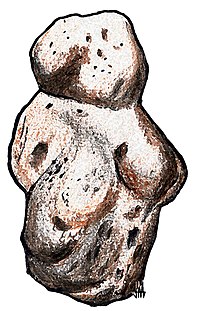Venus of Berekhat Ram

The Venus of Berekhat Ram is a proposed small venus figurine that was found on the Golan Heights.
The base object is an anthropomorphic red tuffic pebble, 35mm (1.4in) long, which has had at least three grooves incised on it by a sharp-edged stone. One is a deep groove that encircles the narrower, more rounded end of the pebble, two shallower, curved grooves run down the sides. These grooves can be interpreted as marking the neck and arms of a figure. They closely resemble marks made in similar material by sharp-edged tools during exercises in experimental archaeology and they can be clearly distinguished from naturally-created lines[1]. It is therefore agreed that that the pebble was humanly-modified, even if it bears little resemblance to the much later Venus Figurines of the Upper Palaeolithic.
Because it was found between two layers of ash, it has been dated to at least 230,000 years before the present. If the artefact was intended to replicate a female figure, it would be the earliest example of representational art in the archaeological record. Rather than being made by modern humans, it would have been made by homo erectus hunter-gatherers and Acheulean tool users. There is some other evidence of an aesthetic sensibility during the period although compelling examples do not appear in the archaeological record until the emergence of modern humans around 50,000 years ago.
See also
Source
Goren-Inbar, N and Peltz, S, 1995, Additional remarks on the Berekhat Ram figure, Rock Art Research 12, 131-132, qtd in Scarre, C (ed.) (2005). The Human Past, London: Thames and Hudson. ISBN 0-500-28531-4.
External links
- Venus Figures from the Stone Age: Russia, Ukraine, and East of the Donau Mouth Picture of the pebble (top).
Footnote
^ d'Errico, F. and Nowell, A, 2000, A new look at the Berekhat Ram figurine: implications for the origins of symbolism, Cambridge Archaeological Journal 10, 123-67.
